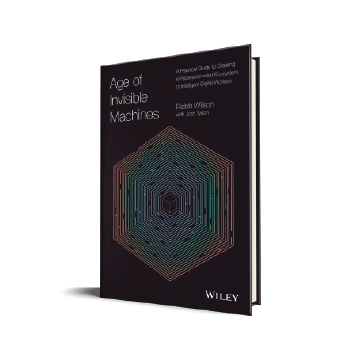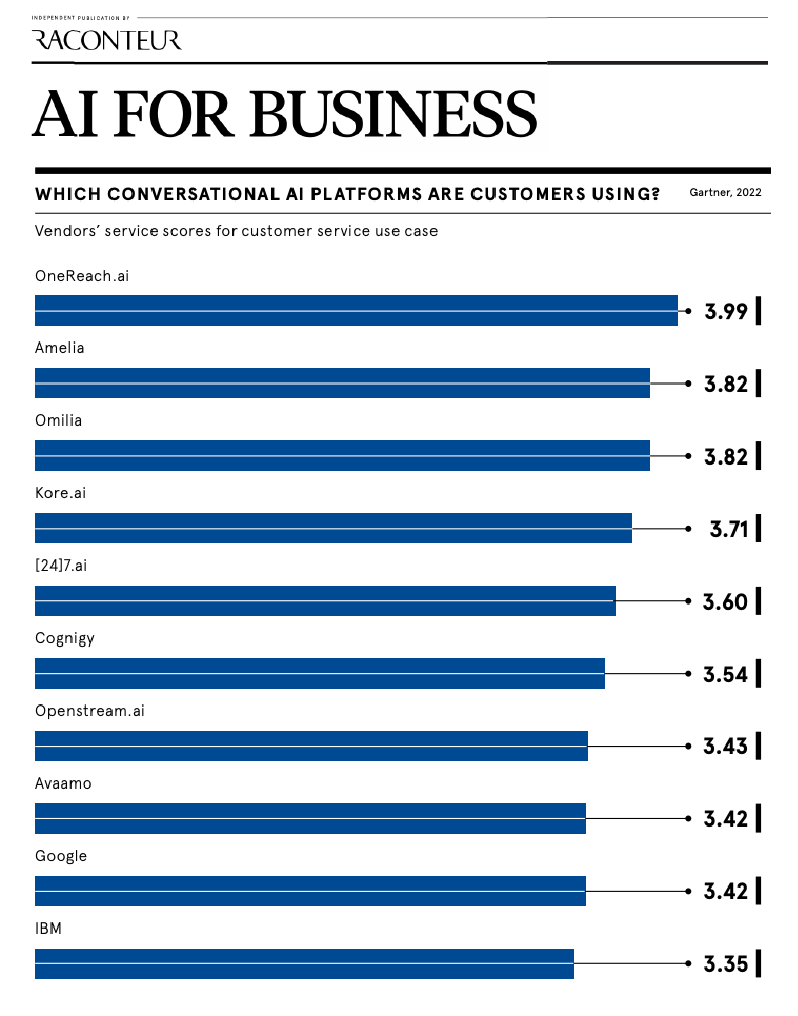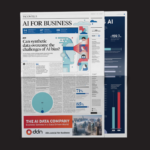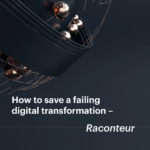
post
June 27, 2022
“I didn’t want AI leaving people behind, so I decided to do something about it” – Interview with OneReach.ai Founder
An interview with OneReach.ai founder, Robb Wilson, where he shares news of his upcoming book, Age of Invisible Machines.
OneReach.ai founder, Robb Wilson, was featured in Raconteur’s AI for Business report in the Sunday Times talking about his upcoming book, Age of Invisible Machines. This interview was originally published by Raconteur.
In this candid conversation, celebrated tech leader and experience design pioneer Robb Wilson talks about the lifelong journey in technology that informed his new book from Wiley, Age of Invisible Machines: A Practical Guide to Growing a Hyperautomated Ecosystem of Intelligent Digital Workers. Equally at home reconfiguring code or designing conversational flows as he is building a house or carving his own surfboard, Wilson’s breadth of experience has proven invaluable in a sprawling and complex space. As the founder of OneReach.ai, his work has come to define the conversational AI marketplace.
Your career began in the film industry. Did that influence your later work?
Definitely. In the early ‘90s, I worked in sound design at Warner Bros., where many of my colleagues had been in the film industry for nearly half a century. At the time, the film world was transitioning from analog to digital. I realized that the wisdom these sound editors brought to their craft was in danger of being lost if the industry started hiring people who were simply better at using computers.
There’s a very distinct rhythm to editing film, and a lot of that comes from the physical act of cutting and splicing celluloid, so I designed a digital editing interface that mimicked the controls of an old school sound editing system. The older, experienced editors were able to acclimate to the digital editing process and younger editors learned the rhythms of working film by hand. The experience showed me how important it is to bridge the gap between humans and machines.
From film you moved into experience design, where you enjoyed considerable success. How did that shape your perspective on conversational AI?
I don’t like waving my accomplishments around, but it’s safe to say that almost everyone on the planet has touched a piece of technology I had a hand in developing. I was tapped to design one of the first iPad apps and, over the years, I’ve worked with many of the largest technology companies in the world. I’ve also collected over 100 awards, which I only bring up because roughly half of them are in technology and the other half are in design. This balance is important, because while conversational AI involves the orchestration of a whole host of complex technologies—like NLU/NLP, code-free design, RPA, and machine learning—its success is entirely dependent on adoption, which can only be achieved by focusing on experience design.
Is that balance between technology and design central to the work you’re doing at OneReach.ai?
Definitely. I’ve been exploring conversational AI for over two decades, and what first drew me in was the fact that, of all the experiences people had with technology, conversational ones were uniformly the worst. Once conversational experiences stop sucking, however, adoption will skyrocket. Conversation is an interface that requires zero training, which gives anyone, anywhere the ability to leverage powerful problem-solving machines. Basically, I didn’t want to see technology—specifically AI— leave people behind, so I decided to do something about it.
It’s been a long and somewhat fraught journey, but we’ve recently hit some huge milestones as a company. The biggest is that OneReach.ai scored highest overall in the Inaugural 2022 Gartner Critical Capabilities for Enterprise Conversational AI Platforms report. For me and my team, it validated our philosophy that the only way to really succeed with conversational AI is to have the ability to orchestrate all the associated technologies using code-free tools on an open platform that’s flexible enough to incorporate the best products that the marketplace has to offer.
Are there other things you’re doing differently at OneReach.ai that we should know about?
Our no-code creation tools make it so that the people building solutions don’t need any of the skills typically associated with a software developer. This has completely changed the way we hire solution designers. We aren’t looking for unicorns who can write code while understanding the nuance and intricacies of design. Building with our platform, the software is, in effect, the direct result of the design process. This frees us up to hire people who are passionate about solving problems.
One of our most successful lead solution designers came to us right out of college with a biology degree. It made no difference to us that she didn’t have a background in technology or design. We saw her as a crack problem solver, and in a few short years on our platform she’s probably designed more unique conversational experiences than entire teams at enterprise-level companies. I don’t think it’s a coincidence that more than half of our designers are women. I was raised by strong women who got stuff done—they were outcome driven, just like the designers on our team.
You also grew up under the direct tutelage of Canadian philosopher Marshall McLuhan.
It was interesting because he was a friend of my mother’s who lived down the street, so he was more like my lovable, grumpy uncle. I didn’t realize how renowned he was outside of my cul-de-sac until years later. He instilled in me a deep reverence for the power of technology. One thing he said that I still think about all the time is this: “We shape our tools and thereafter our tools shape us.” I see evidence of this everywhere. When engineers at Facebook created algorithms with the positive outcome of getting the peak number of eyeballs on posts, they probably didn’t realize that evolved versions would imperil the mental health of an entire generation on Instagram, or that their news feed algorithm would undermine the mechanics of democracy. We are at a critical impasse right now. Conversational AI can quite literally help humans fix the world, but only if it’s used in thoughtful and responsible ways. This will be a tall order as companies the world over scramble to keep up, but I have hope that we can make technology work for humanity in profound and positive ways.
In the AI for Business Report, OneReach.ai is featured as the top conversational AI platform:

Read the full report from Raconteur here.
Stay up to date
Latest Articles

OneReach.ai Named a Leader in the IDC MarketScape for Conversational AI Software 2023
December 18, 2023



